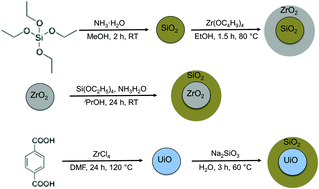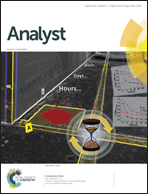Characterization of core–shell MOF particles by depth profiling experiments using on-line single particle mass spectrometry†
Abstract
Materials with core–shell structures have distinct properties that lend themselves to a variety of potential applications. Characterization of small particle core–shell materials presents a unique analytical challenge. Herein, single particles of solid-state materials with core–shell structures were measured using on-line aerosol time-of-flight mass spectrometry (ATOFMS). Laser ‘depth profiling’ experiments verified the core–shell nature of two known core–shell particle configurations (<2 μm diameter) that possessed inverted, complimentary core–shell compositions (ZrO2@SiO2versus SiO2@ZrO2). The average peak area ratios of Si and Zr ions were calculated to definitively show their core–shell composition. These ratio curves acted as a calibrant for an uncharacterized sample – a metal–organic framework (MOF) material surround by silica (UiO-66(Zr)@SiO2; UiO = University of Oslo). ATOFMS depth profiling was used to show that these particles did indeed exhibit a core–shell architecture. The results presented here show that ATOFMS can provide unique insights into core–shell solid-state materials with particle diameters between 0.2–3 μm.


 Please wait while we load your content...
Please wait while we load your content...